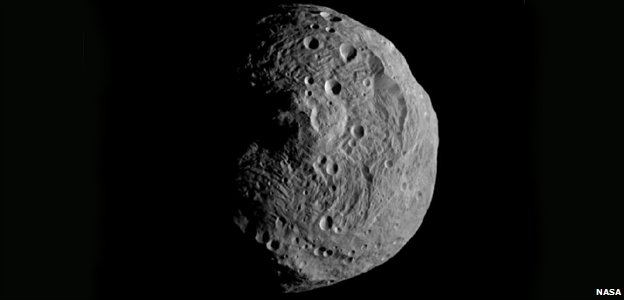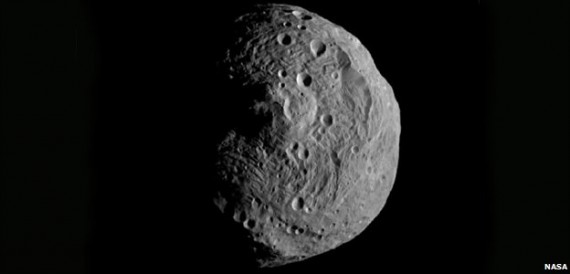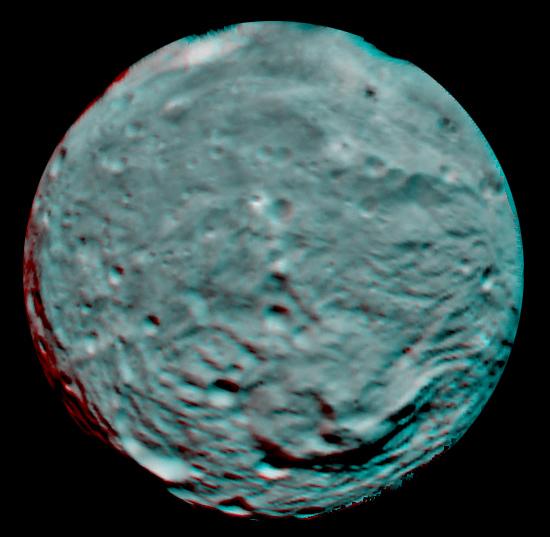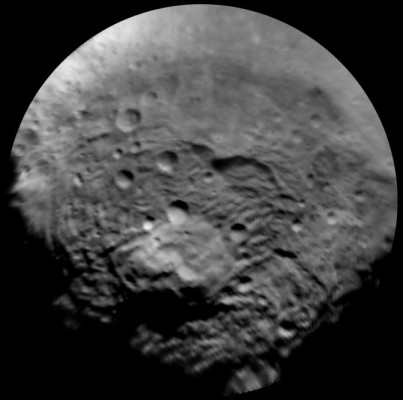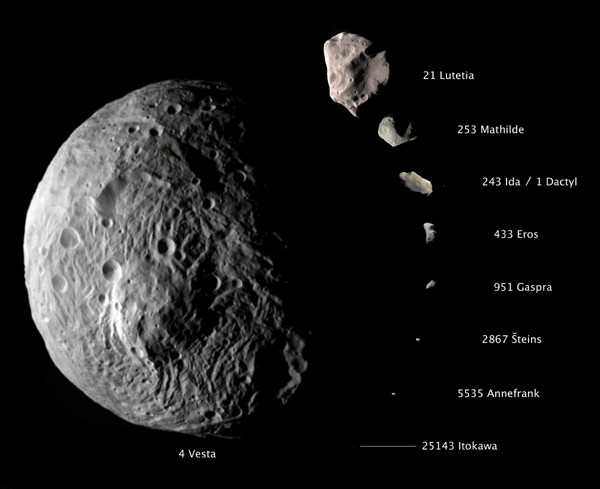With Dawn now safely in orbit around the giant asteroid Vesta, Nasa have released the first close-up image of the ancient protoplanet. [Image credit: NASA/JPL-Caltech/UCLA/MPS/DLR/IDA]
From the accompanying text
July 18, 2011 – PASADENA, Calif. — NASA’s Dawn spacecraft obtained this image with its framing camera on July 17, 2011. It was taken from a distance of about 9,500 miles (15,000 kilometers) away from the protoplanet Vesta. Each pixel in the image corresponds to roughly 0.88 miles (1.4 kilometers).
And from the JPL press release
The image taken for navigation purposes shows Vesta in greater detail than ever before. When Vesta captured Dawn into its orbit, there were approximately 9,900 miles (16,000 kilometers) between the spacecraft and asteroid. Engineers estimate the orbit capture took place at 10 p.m. PDT Friday, July 15 (1 a.m. EDT Saturday, July 16).
Vesta is 330 miles (530 kilometers) in diameter and the second most massive object in the asteroid belt. Ground- and space-based telescopes have obtained images of Vesta for about two centuries, but they have not been able to see much detail on its surface.
“We are beginning the study of arguably the oldest extant primordial surface in the solar system,” said Dawn principal investigator Christopher Russell from the University of California, Los Angeles. “This region of space has been ignored for far too long. So far, the images received to date reveal a complex surface that seems to have preserved some of the earliest events in Vesta’s history, as well as logging the onslaught that Vesta has suffered in the intervening eons.”
Vesta is thought to be the source of a large number of meteorites that fall to Earth. Vesta and its new NASA neighbor, Dawn, are currently approximately 117 million miles (188 million kilometers) away from Earth. The Dawn team will begin gathering science data in August. Observations will provide unprecedented data to help scientists understand the earliest chapter of our solar system. The data also will help pave the way for future human space missions.
They have also released a series of images taken on the 9 July.
Including this 3-D image of Vesta’s South polar region [Image credit: NASA/JPL-Caltech/UCLA/MPS/DLR/IDA]
This anaglyph image of the south polar region of the asteroid Vesta was put together from two clear filter images, taken on July 9, 2011 by the framing camera instrument aboard NASA’s Dawn spacecraft. Each pixel in this image corresponds to roughly 2.2 miles (3.5 kilometers). The anaglyph image shows the rough topography in the south polar area, the large mountain, impact craters, grooves, and steep scarps in three dimensions. The diameter of Vesta is about 330 miles (530 kilometers). Use red-green (or red-blue) glasses to view in 3-D (left eye: red; right eye: green [or blue]).
And an enhanced view of the same region [Image credit: NASA/JPL-Caltech/UCLA/MPS/DLR/IDA]
This image, taken by the framing camera instrument aboard NASA’s Dawn spacecraft, shows the south polar region of this object, which has a diameter of 330 miles (530 kilometers). The image was taken through the clear filter on July 9, 2011, as part of a rotation characterization sequence, and it has a scale of about 2.2 miles (3.5 kilometers) per pixel. To enhance details, the resolution was enlarged to .6 miles (1 kilometer) per pixel. This region is characterized by rough topography, a large mountain, impact craters, grooves and steep scarps. The original image was map-projected, centered at 55 degrees southern latitude and 210 degrees eastern longitude.
And, finally, a comparative composite image of several asteroids. [Image credit: NASA/JPL-Caltech/JAXA/ESA]
This composite image shows the comparative sizes of nine asteroids. Up until now, Lutetia, with a diameter of 81 miles (130 kilometers), was the largest asteroid visited by a spacecraft, which occurred during a flyby.
Vesta, which is also considered a protoplanet because it’s a large body that almost became a planet, dwarfs all other small bodies in this image, with its diameter sizing up at approximately 330 miles (530 kilometers).
Discover more from Slugger O'Toole
Subscribe to get the latest posts to your email.
